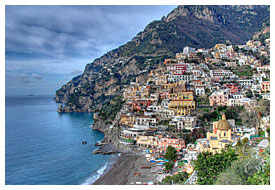 |
 |


About Sorrento
Where is Sorrento?
Local Attactions
Around Sorrento
Sorrento Fondazione
Sorrento Tourism
Naples Tourism
Pompeii Archeological
Society
|
 |

 Sorrento is located on a tuff coast, 48 km from Naples. Suspended between the green hills and the blue Gulf of Naples, this breathtaking area is, from time immemorial, a great visitor attraction in the Campania region, in southern Italy. It is an ideal destination for tourists planning excursions to Capri, Ischia, Pompei, Amalfi, Positano, Ercolano, Paestum and Vesuvius. In addition to its tourist appeal, Sorrento is famous for the production of limoncello, an alcoholic digestif made from lemon rinds, alcohol, water, and sugar.
Sorrento is located on a tuff coast, 48 km from Naples. Suspended between the green hills and the blue Gulf of Naples, this breathtaking area is, from time immemorial, a great visitor attraction in the Campania region, in southern Italy. It is an ideal destination for tourists planning excursions to Capri, Ischia, Pompei, Amalfi, Positano, Ercolano, Paestum and Vesuvius. In addition to its tourist appeal, Sorrento is famous for the production of limoncello, an alcoholic digestif made from lemon rinds, alcohol, water, and sugar.
A Brief History of Sorrento
- Initially a Phoenician colony, Sorrento was founded by Liparus, son of Ausonus, who was king of the Ausoni and the son of Ulysses and Circe. The Ausoni tribe was one of the most ancient ethnical groups in the area.
- Sorrento became a port frequented by Greeks engaged in commercial activity with Naples and with others southern cities during the Imperial period. It was named "Syrenusion" or "Syreon" by the Greeks, which means Siren's land. According to Greek mythology, sirens lurked in these parts, charming passing sailors to their doom. In fact, Sorrento happened to be the site of the Sirens' temple, the only one in the Greek world.
- Sorrento later came under Roman rule. Lured by its beauty, the Romans elected it as the holiday destination of patricians.
- After the fall of the Western Roman Empire, Sorrento was ruled by the Ostrogoths and then returned to the Eastern Empire. In the following centuries, the authority of the distant Byzantium Empire faded, Sorrento became an autonomous duchy. In 1133, it was conquered by the Norman Roger II of Hauteville. From this point, Sorrento's history followed that of the newly created Kingdom of Sicily.
- In 1861 Sorrento was officially annexed to the new Kingdom of Italy.
|
 |
 |


 Sorrento is located on a tuff coast, 48 km from Naples. Suspended between the green hills and the blue Gulf of Naples, this breathtaking area is, from time immemorial, a great visitor attraction in the Campania region, in southern Italy. It is an ideal destination for tourists planning excursions to Capri, Ischia, Pompei, Amalfi, Positano, Ercolano, Paestum and Vesuvius. In addition to its tourist appeal, Sorrento is famous for the production of limoncello, an alcoholic digestif made from lemon rinds, alcohol, water, and sugar.
Sorrento is located on a tuff coast, 48 km from Naples. Suspended between the green hills and the blue Gulf of Naples, this breathtaking area is, from time immemorial, a great visitor attraction in the Campania region, in southern Italy. It is an ideal destination for tourists planning excursions to Capri, Ischia, Pompei, Amalfi, Positano, Ercolano, Paestum and Vesuvius. In addition to its tourist appeal, Sorrento is famous for the production of limoncello, an alcoholic digestif made from lemon rinds, alcohol, water, and sugar.